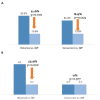Nutrition Care for Poorly Nourished Outpatients Reduces Resource Use and Lowers Costs
- PMID: 34009072
- PMCID: PMC8138290
- DOI: 10.1177/21501327211017014
Nutrition Care for Poorly Nourished Outpatients Reduces Resource Use and Lowers Costs
Abstract
Background and objectives: Over 25% of United States (US) community-dwelling, older adults are at nutritional risk. Health and cost burdens of poor nutrition can be lowered by nutrition programs for hospital inpatients, but few studies have looked at the impact on outpatients. The objective of our study was to assess outcomes of a nutrition focused quality improvement program (QIP) on healthcare resource use and costs in poorly nourished outpatients.
Methods: This pre-post QIP study was implemented at 3 US healthcare system clinics. Included patients (n = 600) were ≥45 years old, had ≥2 chronic conditions, and were enrolled over a 15-month interval. For comparison, historical (n = 600) and concurrent control (n = 600) groups were used. Assessment of poor nutritional status was performed during each patient's baseline visit. Healthcare resource use (hospitalizations, emergency department visits, and outpatient clinic visits), medication use, and costs were determined for a 90-day interval.
Results: QIP patients (mean age 61.6 years) were predominantly female (62.5%) and overweight/obese (81.7%). The proportion of QIP outpatients presenting for healthcare services was significantly reduced compared to both historical and concurrent controls-relative risk reduction (RRR) versus historical (11.6%, P < .001) and versus concurrent (8.9%, P = .003). Of those who presented, RRR for healthcare resource use by QIP was significant in comparison with historical (12.9%, P = .022) but not concurrent controls. No significant differences were observed for medication usage. Lower resource use among QIP patients yielded total cost savings of $290 923 or per-patient savings of $485.
Conclusions: Nutrition QIPs in outpatient clinics are feasible and can reduce healthcare resource use and cut costs. Such findings underscore benefits of nutritional interventions for community-dwelling outpatients with poor nutritional status.
Trial registration: ClinicalTrials.gov NCT03628196.
Keywords: cost-savings; nutrition; oral nutritional supplements; outpatients; patient outcomes.
Conflict of interest statement
Figures




Similar articles
-
Reducing Hospitalizations and Costs: A Home Health Nutrition-Focused Quality Improvement Program.JPEN J Parenter Enteral Nutr. 2020 Jan;44(1):58-68. doi: 10.1002/jpen.1606. Epub 2019 Jun 24. JPEN J Parenter Enteral Nutr. 2020. PMID: 31231830 Free PMC article.
-
Nutrition-Focused Care for Community-Living Adults: Healthcare Utilization and Economic Benefits.Value Health Reg Issues. 2022 Nov;32:70-77. doi: 10.1016/j.vhri.2022.08.005. Epub 2022 Sep 11. Value Health Reg Issues. 2022. PMID: 36099802
-
Budget Impact Analysis of a Home-Based Nutrition Program for Adults at Risk for Malnutrition.Am Health Drug Benefits. 2020 Jun;13(3):95-101. Am Health Drug Benefits. 2020. PMID: 32699570 Free PMC article.
-
Systematic reviews of the effectiveness of day care for people with severe mental disorders: (1) acute day hospital versus admission; (2) vocational rehabilitation; (3) day hospital versus outpatient care.Health Technol Assess. 2001;5(21):1-75. doi: 10.3310/hta5210. Health Technol Assess. 2001. PMID: 11532238 Review.
-
First Clinical Nutrition Outpatient Consultation: A Review of Basic Principles in Nutritional Care of Adults with Hematologic Disease.ScientificWorldJournal. 2023 Sep 21;2023:9303798. doi: 10.1155/2023/9303798. eCollection 2023. ScientificWorldJournal. 2023. PMID: 37780637 Free PMC article. Review.
Cited by
-
Individual-Level Factors are Significantly More Predictive of Employee Innovativeness Than Job-Specific or Organization-Level Factors: Results From a Quantitative Study of Health Professionals.Health Serv Insights. 2022 Feb 23;15:11786329221080039. doi: 10.1177/11786329221080039. eCollection 2022. Health Serv Insights. 2022. PMID: 35221693 Free PMC article.
-
Nutrition-Focused Quality Improvement Programs in Pediatric Care.Children (Basel). 2024 Nov 26;11(12):1434. doi: 10.3390/children11121434. Children (Basel). 2024. PMID: 39767863 Free PMC article.
-
Nutrition's Role in Quality Healthcare in the United States: Opportunities and Education for Pharmacists to Take a Bite of the Apple and Strengthen Their Skills.Pharmacy (Basel). 2024 Jun 29;12(4):103. doi: 10.3390/pharmacy12040103. Pharmacy (Basel). 2024. PMID: 39051387 Free PMC article.
-
Good nutrition across the lifespan is foundational for healthy aging and sustainable development.Front Nutr. 2023 Jan 24;9:1113060. doi: 10.3389/fnut.2022.1113060. eCollection 2022. Front Nutr. 2023. PMID: 36761990 Free PMC article.
References
Publication types
MeSH terms
Associated data
LinkOut - more resources
Full Text Sources
Other Literature Sources
Medical

